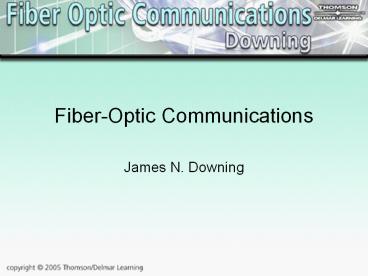Fiber-Optic Communications - PowerPoint PPT Presentation
1 / 18
Title:
Fiber-Optic Communications
Description:
Fiber-Optic Communications James N. Downing – PowerPoint PPT presentation
Number of Views:84
Avg rating:3.0/5.0
Title: Fiber-Optic Communications
1
Fiber-Optic Communications
- James N. Downing
2
Chapter 8
- Optical Signals and Networks
3
8.1 Optical Signal Characteristics
- Electrical-to-Optical Signal Conversion
- The electron is converted to a photopreserving
information that is coded - Optical source
- LED
- Laser Diode
- Regenerated and retimed by clock recovery circuit
4
8.1 Optical Signal Characteristics
- Optical Signal Formats
- OOK
- Uses two signal levelsone and zero
- Two line codesreturn-to-zero and
non-return-to-zero - Return to zero code has twice the bandwidth but
less dispersion - Non-return-to-zero code more commonly used
because of the simplicity but clock recovery is
more difficult
5
8.2 Wavelength Division Multiplexing
- WDM assigns a unique wavelength to each channel
and allows more than one wavelength to be
transmitted in the same fiber.
6
8.2 Wavelength Division Multiplexing
- Dense Wavelength Division Multiplexing
- Developed for the C and L bands
- Consist of 100 channels from 186 THz to 195.9 THz
- Somewhat expensive
- Practical for long-haul high capacity applications
7
8.2 Wavelength Division Multiplexing
- Coarse Wavelength Division Multiplexing
- Allows multiplexing with wider wavelength spacing
- Lower cost
- Easier installation
- Requires no precision laser diodes
- Requires no sophisticated filters
- Choice for metro markets
8
8.3 Optical Networks
- Fiber in the Network
- Characteristics are optimized over the long,
straight runs with few interruptions - Optical Network Transport Protocols
- Fiber Distributed Data Interface (FDDI)
- Provides dual counter rotational ring for CAN and
MAN - Primarily used for storage
9
8.3 Optical Networks
- Optical Network Transport Protocols
- Fibre Channel
- Used for connections of servers to shared storage
devices over short distances - Enterprise system connector ESCON
- Interconnects the S/390 mainframe to storage
- FICON
- Connects mainframe to storage8 times faster than
ESCON
10
8.4 SONET
- Synchronous Optical Network
- What is SONET?
- Provides a standard optical transport
- Operates at the physical layer for framing and
transporting data over fiber optics - Four layers path, line, section, and photonic
layer
11
8.4 SONET
- What is SONET?
- Path layer Defines and controls the end-to-end
communications on the network - Line layer Synchronization and automatic
protection switching (APS) - Section layer Details procedures between optical
repeaters such as framing, scrambling, and error
monitoring - Photonic layer Controls the optical-to-electronic
conversion
12
8.4 SONET
- The STS-1 Frame and Data Formats
- 9 by 90 matrix of 810 bytes
- Transport Overhead
- Contains the section and path overheads for a
total of 27 bytes - Synchronous Payload Envelope
- Contains the matrix of information to be
transmitted (783 bytes)
13
8.4 SONET
- The STS-1 Frame and Data Formats
- 4 of available payload is used for operations,
administration and management. - First two bytes of the line overhead are
pointers, which specify the offset to the first
SPE byte that is allowed to float inside the
allotted space. - Timing is via a precise stratum 3 reference.
14
8.4 SONET
- Advantages
- Standardization and synchronization
- More efficient multiplexing and depmultiplexing
- More reliable, flexible, and expandable
- Less equipment is required
- Reconfigurable network with centralized
management - Ring type topologies
15
8.4 SONET
- Disadvantages
- Rigid rate hierarchy and convergence requirements
- Inefficient use of bandwidths
- Current rate hierarchy is not suitable for
Ethernet transport - Limited node network management functions
- Lack of storage area network
16
8.4 SONET
- Evolving Network Transport Services
- Packet over SONNET (PoS)
- Link Access Procedure (LAPS)
- IP over LAPS
- Ethernet over LAPS
- Generic Multi-Protocol Label Switching (GMPLS)
- Resilient Packet Rings (RPR)
- Multiservice Provisioning Platforms (MSPP)
17
8.4 SONET
- Next Generation SONET (NG-SONET)
- Generic Framing Procedure (GFP)
- Virtual Concatenation (VC)
- Link Capacity Adjustment Scheme (LCAS)
- Smart DWDM
18
8.4 SONET
- Alternative and Hybrid Transport Systems
- Carrier Class Ethernet
- LAN PHY
- WAN PHY
- RPR

